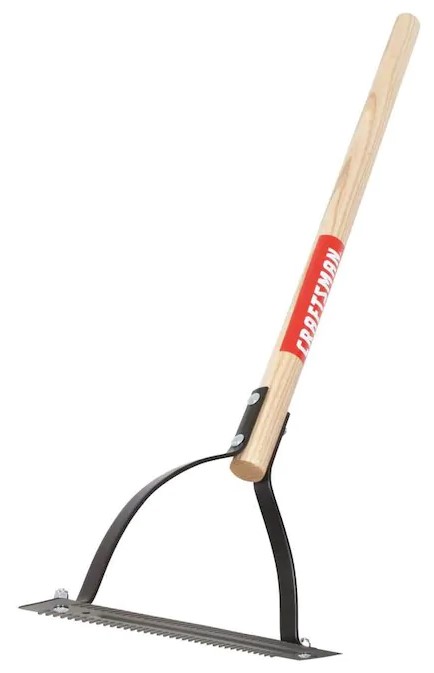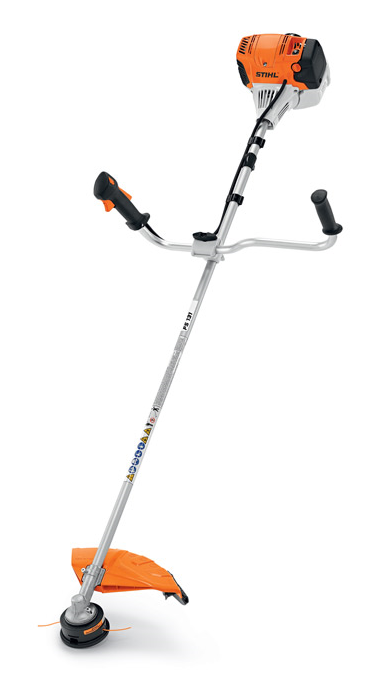STIHL FS 131 for Trail Maintenance
The trail adopter’s manual for the Ozark Trail recommends the use of a hand weeder, which is a tool I’ve always called a sickle, though it really isn’t. It looks like this:

It works well enough, once you get into the swing of it (pun intended), though there is definitely an upper limit to what it can cut. Unfortunately, it gets to be exhausting, and it’s slow going, especially on the neglected trail I am working on. In nine or ten hours of working with it, I have barely covered two miles. Also, on the rocky trail I’m using it on, the blade is already getting fairly beat up.
The trail adopter’s manual also informs me that optionally, I can use a line trimmer. At home, I use a battery-powered trimmer made by Milwaukee, which (despite running on batteries) is by far the most powerful hand-held line trimmer I have used up to now. However, I hold no illusions that the battery capacity could power through miles of woody brush along the trail, and it is heavy enough that I would hate carrying it that long.
So after a bit of thought and a bit of research, I bought a STIHL FS 131.

After my experience with a STIHL chainsaw, there was no doubt I was going to select one of their line trimmers for trail maintenance. I’m glad I did.
I knew I would want a professional model, and I knew it would need to be more powerful than the bottom of the line. The FS 131 is 47% more powerful than the popular FS 91, but weighs the same and only costs a little more. The “bike handle” and the shoulder harness that goes with it is exactly what I need for extended use.
I plan to use it with the 250mm triple-bladed Brush Knife along the wooded parts of the trail, and the DuroCut trimmer head with heavy line for the grassy and weedy sections.
So far, it is amazing how simply and easily this thing starts. It sounds a little like a Harley when it idles. STIHL has done a good job reducing vibration, so it doesn’t feel as powerful as it really is.
Power: Wow. It spins that thick metal blade up like it’s nothing, which then coasts for an impressive amount of time, even while cutting through things.
The Brush Knife is more than adequate for the young woody growth that comes up on and along the trail. Most of it is approximately a quarter of an inch in diameter. The hand weeder needs a swift swing and be used just so to cut through them, and it barely manages. The trimmer with the Brush Knife slices through them like they aren’t even there. It goes through tough, woody, thumb-sized brush with a single cut every time. With some coaxing, it can saw through larger stuff.
I have not yet had a chance to test out the DuroCut trimmer head, but I expect to this weekend. There is a swath of grass at the trailhead of my adopted segment, and some very tall and tough grass where the trail wanders through a power cut. On other parts of the trail, which I intend to support with this, there are fields much like the power cut, and miles of very weedy bottom land. I plan to try both the serrated .120″ DuroCut line, and Oregon’s .155″ Magnum Gatorline Square line.
The shoulder harness works very well, and after running it for quite some time, I am neither sore nor fatigued.
One challenge has been fitting it in my car. It’s kind of long, and it doesn’t separate in the middle. If I was driving a truck to the trail, it wouldn’t be a problem, but I am driving a 5-door Ford Focus. If I fold down the back seats and remove the trimmer head, it just fits diagonally.
So far, I am very happy with this machine. It is my hope that I will be able to get caught up with the whole seven mile loop in one or two outings. After that, I will take a whack (pun intended) at some of the more egregious parts of the rest of the trail section, which is fairly well neglected. If I and the other people focusing on this trail section can whip it into shape, perhaps usage will increase.